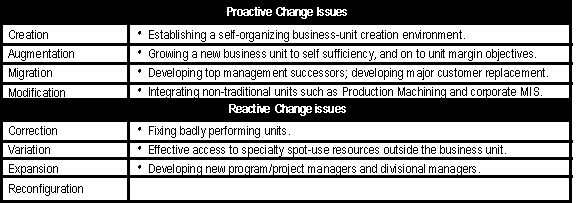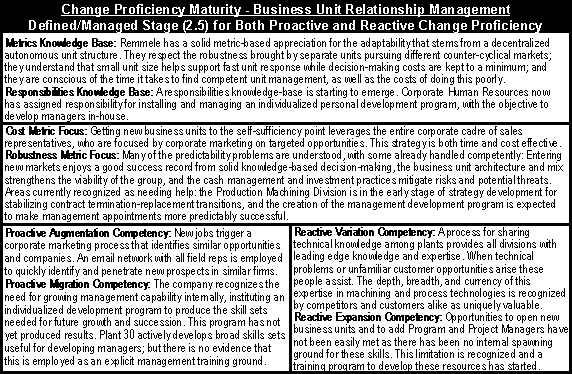Establishing a self-organizing business-unit creation
environment
- The reader is referred to Appendix D that contains an excellent and
necessary description of the organizational structure and organizing principles which will
not be repeated here.
- Though Plant 30 was gained by acquisition, strong ideology at Remmele has
made it difficult to add business units through acquisition: incompatibilities in culture
and valuation are generally too great. This realization has come from experience and has
strengthened the focus on creating an environment that generates new business units from
existing ones. "We started out with machining and with automation as a single
business in one plant (Plant 10). Some people ended up specializing in the parts and
assemblies made for the automation group—so when more work came in and the place got
crowded, these two different businesses were split and the Automation Division was
spun-off (Plant 50)—with two separate P&Ls right away. But the cultural identity
was still one company, just in two locations. The first real recognition of
'differentness' occurred when the third unit was formed by acquisition (Plant
30)—which created some 'we-they' feeling. Eventually Plant 30 split, creating Plant
20 when it was decided that the work-cell (Production Machining) business and the flexible
equipment (Repetitive Batch) business are really very different: Work-cell equipment is
specialized and may be sold off after the job goes away, whereas flexible equipment is
applied to many jobs. The people are different too: different types of operators are
needed for small-part-month-after-month vs. the operator who must run many different types
of jobs with frequent and different setups. We have come to look at this spawning process
with greater understanding and respect as each event occurs; with more decentralized
autonomous empowerment concepts reflected in our Strategic Policies (see Appendix) as the
years have passed."
- "Back in the '50s Fred Remmele felt that relationships with a
customer were better if a Project Manager was the single-point customer interface, who
also had full responsibility for the relationship as if it was his only business. The
Project Manager concept started when Remmele was only a $3 million business. As plants
spun off, it became evident that Project Managers could not be centralized at Plant 10
(where everything started), and instead had to be in the plant that did their work.
Eventually we recognized that Project Managers in different plants required different
skills. At Plant 30 you had long-term management and little new business work, whereas the
Plants 10/40 Division needed just the opposite. There were also differences in working
with portable carryable parts vs a heavy or large part that needed a crane—how you
schedule and manage those
- jobs was very different. This meant we really had different kinds of
project managers. Project managers have to be real self-motivated, as they are responsible
for building a business without much direct management."
- When one of the shop people involved with bringing in new high-velocity
machining technology was asked: "What’s unique about this place?", the
prompt answer was: "It splits into two before it gets too big. People in the weekly
meetings are asking when our place is splitting and why it hasn't happened yet."
Someone interpreting this answer later suggested that people in the plant can’t help
but see that there is no room for the high velocity machining equipment unless some of the
existing activity vacates the building—and there is a candidate
business-in-the-making there that is close to striking out on its own.
Growing a new business unit to self-sufficiency and on to unit margin
objectives
- Whenever a major new type of job is secured by Remmele, whether for a new
or existing business unit, a process is invoked by marketing which identifies similar
types of needs and companies throughout the United States likely to have those needs. If
justified, a target account program is developed and sales reps are involved in further
research and market penetration activities. For some time now there has been an e-mail
network specifically set up for the sales representative interactions with the company,
and this network is one of the tools used to monitor and modify these market penetration
programs in real-time.
Developing top management successors; developing effective customer
replacement
- Typically the head of a company in this industry is a technologist and
not a marketer, most likely a machinist in background. That is not the case at Remmele,
where strong marketing experience is evident in senior management. What is equally evident
among senior management is natural "people-person" skills backed up by a deep
visceral feeling for the values, development, and maintenance of the ideological core of
Remmele. Whether consciously done or not, there is active business engineering at work
here; with senior management guiding the explicit formulation and refinement from
predecessors of the key corporate practices: accountable empowerment, decentralized
autonomy, informed risk, project management, professionally classic sales and marketing,
open communications, broad employee involvement in decisions and the annual planning
activity, and so forth. Importantly, management takes an active role in helping others
understand and utilize the core principles at Remmele. Though it is clear that the
ideology is well understood and embraced broadly throughout the company, developing and
maintaining it is a special skill that may be difficult to replace. Recently the company
has recognized the need for growing management capability internally and has instituted an
individualized personal development program aimed at producing the skill sets needed for
Remmele's future growth and succession.
- Customer replacement skills are especially necessary in a business that
does customized outsourcing. The focused-factory cells at Plant 30 typically make sizable
commitments for multiple years to individual customers and build dedicated production
cells to satisfy those commitments. Contracts that run their course and don't result in
renewal or next-generation succession can remove a sizable amount of monthly revenue and
surplus an equally sizable amount of valued human resources. Plant 30 has recently dealt
with just such an occurrence and now understands the necessity for an ongoing replacement
strategy that greatly shortens the disruption period. At this writing the gap is well on
its way to being filled by several new programs in new markets.
Integrating non-traditional units such as Production Machining and
Corporate Information Systems
- The Production Machining Division (Plant 30) functions quite differently
from other Remmele divisions. The focused-factory work-cell concept has caused this plant
to train people in numerous skills, like purchasing, maintenance, and other business
functions, while machinists in other plants tend to have more traditional machinist
training, not including some of those business skills. Similarly, machinists at the
Automation Division (Plant 50) often gain skills in machine assembly that are not common
in the other plants. Remmele's continuing growth and the changing business environments
will require that such different skill sets, including information technology, be
recognized and valued for the advantages they bring to the company overall, and that some
of these skills will be transferred between divisions.
Fixing badly performing units
- "Patience, Perseverance, Leadership, Teamwork" are banner
slogans that graced Remmele's celebration when the Automation Division came out of its
slump. Remmele stuck with this division through several very difficult years. The decision
to fix it rather than close it rested on many factors. Though the company's stable
employment commitment played a role, employees could have been transferred to the other
growing divisions.
- More decisive was the value placed on business diversity, and that this
division provided entrée into a first-class customer base for the other divisions. Also
there was a belief that the problems were of their own making and that it was possible to
succeed in the business. "The business had grown up making some things that were
variations of a common theme. We got good at it and kept doing it. Then markets
disappeared all of a sudden, and we didn’t have anything. All of a sudden we had to
succeed on one-of-a-kind jobs, and we didn’t have the necessary skills. Then we took
some long-term jobs that turned out bad. We had to regroup and start over and go back to a
customer base that we had disappointed. Also we had a managerial strength problem. We had
the time to fix it. We knew all of those people as family and didn’t want to mess up
here—we just had to find a way. All the while various things were tried, and new
management was engaged and held accountable for corrective action. A conscious decision
was made to get it fixed, and perseverance was practiced. The division is reborn in a
different image now and quite vigorous." It is worth noting that the intense focus
and concern on this division's return to health did not cause the company to suspend its
principles of autonomy and empowerment while holding new divisional management
accountable.
Effective access to specialty spot-use resources outside the business
unit
- Internally, Remmele provides a centralized resource that actively
maintains a current knowledge base of leading-edge process and equipment technology and
makes these resources available to other divisions in need of special expertise.
Externally, Remmele outsources NC programming—though recognized as important, there
has been no compelling reason to bring it all inside and set up dedicated capabilities.
Developing new project/program managers and divisional managers
- The corporate Human Resources group has recently instituted an
individualized personal development program for all people in management positions of any
kind—from the president to the shop-floor supervisors. An outside firm with expertise
in the field assists in annual one-on-one consultations to help establish objectives and
strategies for personal development in the ensuing period. The impetus for this program
arose with the realization that Remmele had excellent technology training programs but
generally had to bring some project and program managers, as well as divisional managers,
in from the outside, as there were no in-house training grounds to develop management
skills. Interestingly, the Production Machining Division started its focused-factory
concept in 1989, where people in the cell take on broad business management
responsibilities in addition to the cell operation activities. There is no evidence that
this approach has been consciously employed as a management training ground—perhaps
because its operating modes are devoted to a different type of business than the other
divisions. The example of employee empowerment, however, has been recognized throughout
Remmele.
|
 Paradigm Shift
Paradigm Shift Paradigm Shift
Paradigm Shift
